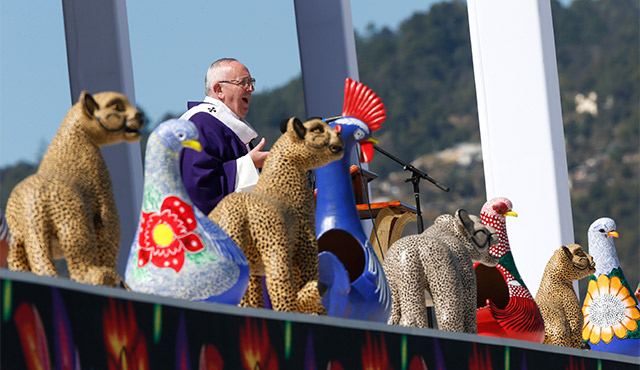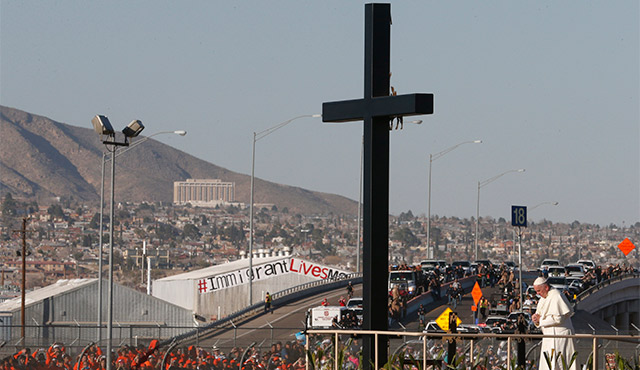When Pope Francis celebrated that historic Mass in the scruffy border town of Juarez during his recent visit to Mexico, he decried the “human tragedy” surrounding the tumultuous issue of illegal immigration. While provocative, the pope’s statement merely was the latest in many pointed dialogues initiated by Vicars of Christ.
Popes have served as spokesmen for Christianity from the earliest times, explains Brother Charles Hilken, professor of history at St. Mary’s College of California and chair of the Bishop John S. Cummins Institute for Catholic Thought, Culture and Action. “While we no longer need our pope to be a political leader as they had to be for many centuries, popes have been effective spokesmen and a real force for Church unity.”
The Gospels are clear that Jesus singled out Peter to function in a special leadership role over the other 11 apostles, “You are Peter and upon this rock I will build my Church,” notes Rev. Msgr. Arthur A. Holquin, Episcopal Vicar for Divine Worship at the Mission Basilica San Juan Capistrano. “Venerable tradition has it that St. Peter became the ‘overseer’ and shepherd of the Christian community in Rome. His commitment to this early community was sealed by his death for Christ in martyrdom on Vatican Hill.”
Since then, Peter’s successors as Bishops of Rome have assumed the special role or charism among the world’s bishops as the one called to be the symbol of the Church as “one, holy, Catholic and Apostolic,” Msg. Holquin adds.
Yet history shows that the men who became the Vicar of St Peter embodied a range of the holy, political and sometimes malicious. Brother Charles calls the papacy “a roller coaster ride through history,” with colorful, saintly, notorious and calculating popes along the way. Pope Julius II, who built St. Peter’s Basilica, was a warrior pope who was as comfortable on the battlefield as at the altar. Pope Urban VII was known as a patron of the arts – but also as the pope who condemned Galileo. Pope John VII, the first pope who commissioned papal portraits, turned forgotten pagan temples into churches. Some popes were lawyers, others were monastics who preferred solitary prayer, and some were theologians who left behind legacies of great writings, Brother Charles says.
Still, while some historic papal roles are in the past, today’s pope remains the world’s ethical, moral leader and evangelizer, explains Father Troy Schneider, vicar of Holy Family Cathedral.
“Ultimately, the people want a pope to be holy, one that will give them the example of virtue and Christian integrity,” Father Troy says. “Depending upon the times and the culture, that was the way it was from the beginning as Peter led the people in the teachings of Jesus Christ.”
Yet each pope shapes the papacy in his own way. “Pope Benedict XVI recently gave us a beautiful example of the fragility of humanity in service when he stepped aside, saying he could no longer serve,” Brother Charles says. “That’s very new and a fine example of leadership.”
Another recent illustration of a pope’s thoughtfulness is Pope Francis’s choice of name, Brother Charles notes. “He is the first pope since Pope Lando (913-914) to choose a name never used in the papacy. Significantly, he chose the name of Francis, a saint who served in the margins of society, preaching to the poor and sick. He is trying to emulate that.”
PAPAL TIMELINE
St. Peter, died circa 64. The first disciple called by Jesus, he also is credited with writing two letters that appear in the New Testament. St. Peter was the first pope to be martyred and the first to become a saint.
St. Sylvester I, 314-335. During his pontificate, the first ecumenical council in Nicea was held. Construction of St. Peter’s Basilica began in 330. The seat of the Roman Empire was moved to Constantinople in 331.
John III, 561-574. Muhammad (570-632), the founder of Islam, was born during John III’s papacy.
St. Martin I, 649-655. He was the last pope to be recognized as a martyr.
Constantine, 708-715. He spent one full year in Constantinople to improve relations between Rome and the East.
St. Leo III, 795-816. During his papacy, Charlemagne is crowned the first Holy Roman Emperor in 800.
Sergius, 904-911. He represents one of the most corrupt periods of the papacy.
Blessed Urban II, 1088-1099. The first university with the authority to grant degrees is established in Italy in 1088. The Crusades, a series of attacks by Western Christians against the Muslims to take control over Jerusalem, continue for the next 92 years.
Blessed Eugene II, 1145-1153. He proclaimed the Second Crusade in 1145.
Alexander III, 1159-1181. He imposed penance on King Henry II for the murder of St. Thomas of Becket in 1172.
Innocent III, 1198-1216. He was the high point of the medieval papacy and exercised considerable political and spiritual power. In 1215, King John issued the Magna Carta.
Innocent IV, 1243-1254. He was the first pope to approve the use of torture in the Inquisition to obtain evidence of heresy.
Urban IV, 1261-1264. The high point of Gothic Architecture, the massive Chartres Cathedral, is consecrated in 1260.
Clement IV, 1265-1268. St. Thomas Aquinas begins writing the SummaTheologica, which unifies faith and reason.
Nicholas, 1277-1280. He was the first pope to make the Vatican Palace his residence.
Clement V, 1305-1314. His papacy began the period known as the Avignon popes.
Gregory XI, 1371-1378. Persuaded by Saint Catherine of Siena to return the seat of the papacy to Rome, he was the last of the Avignon popes.
Urban VI, 1378-1389. He was the last non-cardinal to be elected pope. The years 1378-1417 are known as ”the great Western Schism,” a period of crisis when rival popes claimed papal authority.
Nicholas V, 1447-1455. He was the first of the Renaissance popes and a strong patron of the arts.
Sixtus IV, 1471-1484. He built the Sistine Chapel.
Alexander VI, 1492-1501. Christopher Columbus landed in America
Leo X, 1513-1521. The Protestant Reformation began during Leo’s pontificate.
St. Pius V, 1566-1572. He enforced the decrees of the Council of Trent and published the Roman Catechism.
Gregory XIII, 1572-1585. He adopted the Gregorian calendar, which is still in use today. He also was a strong supporter of the missions in India, China and Japan.
Paul V, 1605-1621. Known for his positive accomplishments in Church renewal, ironically he is best remembered as the pope who censured Galileo for teaching the Earth revolves around the sun.
Pius VI, 1775-1799. He denounced the French Revolution and was later imprisoned by Napoleon. The American Declaration of Independence is signed in 1776.
Pius VII, 1800-1823. In 1804, Napoleon declares himself emperor of France.
Pius IX, 1846-1878. His 31-year pontificate is the longest in history. He called the First Vatican Council, which defined papal infallibility and supremacy. The American Civil War takes place between 1861-1865.
Leo XIII, 1878-1903. Known for his efforts to bring the Church into open dialogue with the world, Leo XIII is considered the first of the modern popes.
Benedict XV, 1914-1922. His is remembered as a peacemaker both within the Church and among the countries who participated in World War I.
Pius XII, 1939-1958. His papacy was indelibly marked by the times – namely, World War II and the following Cold War period. He devoted his energy to world peace, fighting Communism, and to Marian piety. In 1957, the Soviet Union successfully launches the first satellite.
John Paul II, 1978-2005. The first Polish pope in history is also history’s most-traveled pope. His extensive writings and speeches cover just about every major issue from freedom to materialism, to the modern search for meaning and the sacred, to world peace and social justice among all countries, rich and poor.
Some Popes of Note:
St. Leo (the Great), 440-461.
He and Pope Gregory (590-604) are the only two popes to be called “the Great.” His encounter with Attila the Hun, at the very gates of Rome persuading him to turn back, remains a historical memorial to his great eloquence.
Boniface IV, 619-625.
Known for his compassion to the poor, he distributed his entire wealth to the needy. Late in life he converted his own house into a monastery and lived as a prayerful monk.
Clement VI, 1342-1352.
He advanced the practice of indulgences, the abuse of which would contribute to the Protestant Reformation 200 years later. Clement chose to stay in Avignon during the Black Death and survived the worst of the plague.
Clement VII, 1523-1534.
After considerable procrastination, Clement accelerated the breaking of the English church from Rome by refusing to grant a divorce to King Henry VIII.
John XXIII, 1958-1963.
Perhaps the most beloved of all popes, John XXIII visited the sick, the poor and prisoners. Perhaps his most influential decision was the call for an ecumenical council, which would become known as Vatican II.


